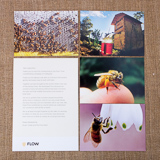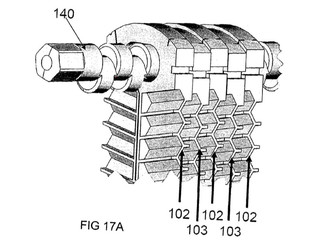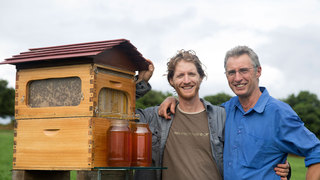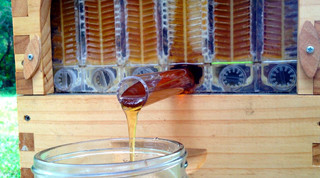Flow Hive puts honey on tap directly from the beehive
Australian beekeepers Stuart and Cedar Anderson invented the Flow Hive, a beehive tap that extracts honey through a specially designed frame with minimal disturbance to the bees and significant reduction in labor. They have been working on this invention for a decade and for the past three years have been field testing their Flow Hive design. The main issue with bee keeping is that it is nearly impossible to get the honey out without killing or injuring bees. The Flow Hive gives anyone the ability to harvest honey with little or no disturbance to the bees. Simply turn the honey tap and the honey drains right out of the bee hives. Easy for the beekeeper and less stressful for the bees.
Through a Indiegogo campaign, the inventors hope to inspire a new generation of beekeepers who will find that harvesting honey is easier, more gratifying, good for the planet, and not as harmful to the bees.
Watch the video
How does it work?
The Flow frame consists of already partly formed honeycomb cells. The bees complete the comb with their wax, fill the cells with honey and cap the cells as usual. When you turn the tool, a bit like a tap, the cells split vertically inside the comb forming channels, allowing the honey to flow down to a sealed trough at the base of the frame and out of the hive, while the bees are practically undisturbed on the comb surface.
When the honey has finished draining, you turn the tap again in the upper slot which resets the comb into the original position and allows the bees to chew the wax capping away, and fill it with honey again.
Each Flow frame is designed with a unique transparent end allowing you to see into the hive. This means you can watch the bees turning nectar into honey and see when each comb is full and ready. Both children and adults get excited seeing the girls at work in their hive. Importantly you will be able to keep an eye on colony numbers thus giving you early detection of any problems within your hive.
For more information see this patent application and official FAQ page. Also you can watch this close up video of what happens when the honey is harvested from the frame.
Flow Hive Indiegogo campaign
On 23 Feb 2015 inventors launched crowdfunding campaign on Indiegogo. In less than 5 minutes already more than $40,000 USD collected. As I write this text, the campaign has raised more than $1M (of $70,000 initial goal): https://www.indiegogo.com/projects/flow-hive-honey-on-tap-directly-from-your-beehive.
 UPDATE: This is officially the fastest project to both the one million and two million dollars on Indiegogo ever! Overall, the fundraising campaign lasted from February 23 to April 19 and amounted to about $12M, exceeding its initial goal more than 170 times. Starting from May 15, Flow Hives and Frames are available for purchase through Indiegogo's InDemand program.
UPDATE: This is officially the fastest project to both the one million and two million dollars on Indiegogo ever! Overall, the fundraising campaign lasted from February 23 to April 19 and amounted to about $12M, exceeding its initial goal more than 170 times. Starting from May 15, Flow Hives and Frames are available for purchase through Indiegogo's InDemand program.
The Buzz Around the Web
To raise initial interest ahead of the funding campaign the Andersons put together a promotional video they hoped would be seen by a few hundred beekeepers interested in the concept and started circulating it on Facebook. What they didn't anticipate was that the video would go viral and become a social media sensation.
Michael Bush (bushfarms.com)
The product is real. I was sent one box worth of the frames to test and have seen it in operation and in person. I thought it was impossible when I first saw a video. I actually wondered if it was a spoof or if it was real. But after seeing how it works and watching them do one frame in the open live on skype while I could see the entire frame and talk to them and after they sent me a box worth of them to test, I can assure you it works. My test of it so far is too small and over too short of a time to be sure what I think of it in practice, but I can't imagine that I'm going to find too many disadvantages. I'm not sure how I will manage my hives using them as it changes several things I have always done. First, I run all eight frame mediums and these are deeps, so I'll have to buy some deeps (which I already did). Second, it makes a hive much more static in size when you can empty the combs without even opening the hive really. No need to stack the supers up so high when you can just drain them periodically without having to clean up the extractor and all the equipment and the kitchen every time. Just draining it into a bucket eliminates all of that mess. The queen won't lay in them because they are too deep so you don't need an excluder (which I don't use, but some people do). You don't have to run the bees out to harvest so you eliminate all of that part of harvesting as well.
When I first saw it I thought of this story from "Mastering the Art of Beekeeping" by Ormond and Harry Aebi:
'I want to buy one of your beehives' he said. 'I want you to bring it to me tomorrow at eleven in the morning and I want you to set it up on top of a ten foot pole that I'll have set up by that time. And I want you to come over every Thursday afternoon and drain out the honey so that I can have fresh honey every week.'...
'I can't place a beehive up on a pole like that,' I said. 'And even if I could, I couldn't work it to take off the honey.'
'Why not? I shall expect you to install a spigot at the bottom of the hive. All you'll have to do is open it and drain off the quantity of honey I require.'
'Beehives don't work that way,' I told him. 'I can't possibly do as you ask.'...
-- Michael Bush, also see his response on YouTube
Rusty Burlew (honeybeesuite.com)
Whether it works or not is anybody’s guess. If you uncap a frame of honey and hold it upside down, not much happens, so I imagine it is the heat of the hive that makes the honey runny enough to flow. So if you have a cold hive, or especially viscous or partially crystallized honey, I imagine you could have trouble with this.
Now I have nothing against innovation, so if that’s what these folks want to promote and sell, they’ve got the right. But honestly, I see nothing good about it for the bees.
In fact, of all the honey bee-related problems in the world, how to get the honey out is not high on the list. The promoters say the system is good for bees because you can harvest the honey without stressing them. But does that mean you take honey without evaluating how much remains for the bees? Are you keeping bees without checking for diseases or mites? Can all good beekeeping practices be ignored? I saw nothing about managing mites, Nosema, moths, beetles, viruses, mice, or foulbrood.
If you want to learn beekeeping, you start by learning about bees - how to collect their honey should be the last thing on your mind. Unless you can raise large healthy colonies that make honey in the first place, no amount of invention will help you remove it.
My crystal ball tells me the project will get funded, the hives will get produced, a few people will extol their virtues, but after a while the mania will Flow™ away in favor of the next great beekeeping invention. - Rusty Burlew, Honey Bee Suite
Phil Chandler (biobees.com)
First, it is not a new hive, but simply an add-on to a conventional hive - really just a set of special frames, and only for honey, not brood. This removes many objections on the grounds of 'propolis jamming it up' and 'eggs laid in plastic foundation' - they are simply not going to happen if it is used correctly.
I don't like plastic in hives - particularly plastic foundation - and I don't like unnecessary disturbances in the lives of bees, BUT - this device actually reduces such disturbance, as well as removing the need for a centrifugal extractor and other extraction/bottling equipment, so from that point of view, it is 'greener', provided it has a long life, which it should have, given that the moving parts only move infrequently and with little load stress.
As a piece of thoughtful engineering I think it is remarkable. I was invited to look at it and contribute my thoughts about 6 months before the launch, and while I expressed some reservations - particularly about crystallization of honey in the combs - I could see that, for some people, this was what they had been waiting for to take up beekeeping.
I still prefer to do my beekeeping in top bar hives, because of their simplicity of construction and use and bee-friendly design, but given that many people prefer to use movable-frame hives, I see this device as a possible alternative to the 'box-removal and centrifugal extraction' method that may appeal to some beekeepers. - Phil Chandler, author of "The Barefoot Beekeeper"
Kirsten Bradley (milkwood.net)
Despite my mission to focus on positivistic messages of change, at Milkwood we’ve got a charter of calling a spade a spade.
And to call yet another plastic beehive addition which does not benefit the bees but only the beekeeper... what it is.
Bees want to build their own wax comb. It’s part of the bee superoganism. The wax is literally built from their bodies.
The comb is the bee’s home, their communication system (which doesn’t work nearly as well if it’s made from plastic rather than bee-drawn wax, as discussed in Tautz), and functions as a central organ.
And given a choice, bees do not want a pre-built plastic womb, home or larder, any more than we would.
The other concern we have with this device is that it encourages + celebrates beekeeper-centric beekeeping, and infers that bee stewardship is totally easy. It’s all about the punchline.
What we’re really talking about here is the wider, industrialised profit-driven approach to beekeeping (as exemplified by the langstroth hive design), which places production above ethics + long-term bee health.
And if we continue to view bees and beekeeping as a gimmick or a system where honey harvest is paramount and the health + needs of this incredibly important species are secondary, we will deserve to lose them. -- Kirsten Bradley, Milkwood Permaculture
Other interesting discussions
- Beesource.com http://www.beesource.com/forums/
- Permies.com http://www.permies.com
- HackerNews https://news.ycombinator.com/item?id=9083207
- Reddit /r/videos, /r/Beekeeping/
- Quora What do you think about Flow Hive?
- Natural Beekeping Trust The Culmination of Callousness, The Deeper Message of the Flow Hive
- Geektimes.ru https://geektimes.ru/post/246336/
- Tehne.com http://tehne.com
Flow Hive image and video gallery
More galleries
Links
- Indiegogo https://www.indiegogo.com
- Official site http://www.honeyflow.com/
- Facebook page https://www.facebook.com/flowhive
- Twitter https://twitter.com/flowhive
- Instagram https://www.instagram.com/flowhive/
- Going With The Flow film
- Flow Hive Turns One
Spread the word!
Flow Hive puts honey on tap directly from the beehive!
Of all the honey bee-related problems in the world, how to get the honey out is not high on the list.









